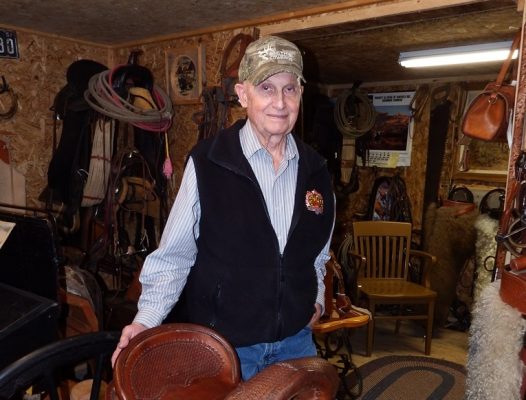
Glen Thompson is a master saddler and one of the few remaining artisans skilled in the specialized craft of hand-made western saddlery.
At his home in Huntsville, nestled in the bucolic Ogden Valley, Glen welcomes me into his shop—a virtual time machine festooned with tools, tack and relics dating back to the 1800s.
The first thing I notice is the aroma. The smells of rawhide and leather both old and new permeate the rustic interior of the saddlery, combined with the fragrances of saddle soap, horse blankets and nostalgia. A sign on the wall proclaims “The shop was clean last week (sorry you missed it),” but from what I can see, everything is in its rightful place, from the smallest tack hammer to the restored buckboard wagon in the back.
Glen is a soft-spoken man who became interested in arts and crafts in high school, and he earned a certificate of apprenticeship in leatherwork from the state in 1960. After a two-year stint in the Army, Glen spent the next 24 years working for J.G. Read Brothers Saddlery in Ogden. “I had to get a full-time job to support my hobby,” he chuckles.
 Glen explains the intricacies of saddle making so that even a city slicker like me can understand. At the heart of every saddle is a saddle tree which gives the saddle its shape. Saddle trees are made from sugar pine or ponderosa. The second most important part of a saddle is the horn.
Glen explains the intricacies of saddle making so that even a city slicker like me can understand. At the heart of every saddle is a saddle tree which gives the saddle its shape. Saddle trees are made from sugar pine or ponderosa. The second most important part of a saddle is the horn.
“Saddle horns have evolved with time,” Glen says. “The old buckaroos would have a saddle with a brass horn or a nickel horn. Often times, the horn is covered with rawhide which is green cowhide with the hair taken off.” After being soaked in water, it is sewn over the horn where it shrinks and dries rock-hard.
Saddle making is a dying art, according to Glen. “The horse business,” he laments, “is kind of fading out. There are NO TRESPASSING signs everywhere.” And assembly line saddle making has usurped the artisan’s craft. There are fewer than six people in Utah who still make saddles by hand, Glen says.
Glen’s saddles have been sold across the country and around the world, and have been displayed at the Smithsonian in Washington, D.C. In the 1980s, Glen was commissioned to make a saddle for then-governor Norman Bangerter, who claims to have put over a thousand miles on it despite the fact that it never rested on a horse. Instead, it stood proudly next to the desk in his office where he sat in it every chance he had. Stamped into the leather were the words “The Guv.”
Glen sells his saddles directly to the buyer, and it’s a mark of prestige to own a Glen Thompson saddle. Every saddle is a unique work of art, and with over 80 hours of meticulous crafting, a fancy show saddle can boast a $6000 price tag. “That is, if you can find a buyer for it,” Glen says. “But people who show horses want top-of-the-line stuff.”
A well-cared-for saddle will last a lifetime or longer. Glen has a saddle in his collection that is over 100-years-old, and another that belonged to the U.S. Cavalry.
Standing beside the most beautiful saddle I’ve ever seen, Glen says, “After fifty years I figured I’d better make me a saddle of my own.” With a smile he adds, “Every cowboy needs a saddle.”
You can contact Thompson Saddlery at 801-745-2313 and at saddledoll@msn.com.







